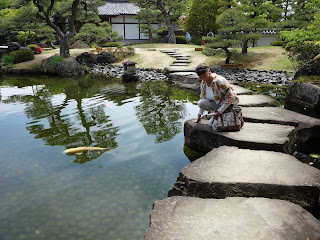Day 10 dawned sunny and early for us as we were to arrive in Kobe around 9 am and we wanted to ensure we had the time to enjoy our delicious breakfast, instant coffee and to view the Akashi Kaikyo Bridge as we entered the port of Kobe.
The Akashi Kaikyō Bridge is a suspension bridge, which links the city of Kobe on the Japanese
mainland of Honshu to Iwaya on Awaji Island. It crosses the busy Akashi Strait on the Inland Sea. It has the longest central span of any suspension bridge
in the world, at 1,991 metres (6,532 ft).
Right on time, we docked at the port of Kobe Sannomiya Ferry Terminal. Nonie was all smiles. From the terminal we were to catch a commuter train that would take us in to Kobe Sannomiya Train Station and our hotel located only a few blocks away.
As we walked off the ferry we were followed by the English couple who had joined us on the ferry in Shanghai. We did not see much of them on the ferry. They followed us to the small urban train station located next to the terminal. We started to talk and discovered that they were also joining us on the cruise to Vancouver. Their journey was almost a mirror image of ours. Fly to Shanghai from England, catch the ferry to Japan, spend a few days in Kobe, travel to Tokyo for a few days before catching the cruise to Vancouver. We separated at the train station where they to were staying at an Air b & b only a few blocks from the hotel.
Tonight, my plan was to find a Kobe Beef restaurant and tuck into one. It is the Holy Grail of meat.
“Wagyu” refers to any cattle that is bred in Japan or the
Japanese-style. Kobe beef is comprised of a very particular strain of Wagyu
called Tajima-Gyu that is raised to strict standards in the prefecture of
Hyogo. Hyogo's capital city is Kobe, thus the name “Kobe Beef”. A major factor in the quality of Kobe steaks is the uncompromising regulations the region uses for its cattle.
To be labelled Kobe, cattle must meet the following seven
standards upon slaughter. Bullock (steer) or virgin cow. Tajima-Gyu born within Hyogo Prefecture. Fed
on a farm within Hyogo Prefecture. Meat processed within Hyogo Prefecture. Marbling
rating (BMS) of 6 or higher on a 12-point scale. Meat quality rating of 4 or
higher on a 5-point scale. An overall weight not exceeding 470 kg.
Because of
these stringent standards, only 3,000 head of cattle qualify as authentic Kobe
cattle each year. In Kobe, the Mitsukoshi department store sells 870 grams for
31,500 Yen ($343 CDN a pound). Translate
that into a 16,000 Yen ($177 CDN) for a 250-gram steak in a restaurant. No virgin beef for us, so it was Wagu and even that set us back 7,500 Yen ($83 CDN)
Kobe Beef is not readily available outside of Japan but you can buy true Wagyu Beef in Costco for $109.00 USD per pound but must buy a minimum of 11 pounds. I believe that that having eaten beef in Kobe I can look you in the eye and say with a straight face that I have eaten Kobe Beef.
Day 11, and we were off to the city of Himeji, about an 60 minute train ride from Kobe. This was our first time traveling on the much vaunted Japanese train system. It lived up to it's reputation.
Himeji is home to the White Crane Palace also known as Himeji Castle is the largest and most visited castle in Japan, and was one of the first UNESCO World Heritage Sites in the country. It has been around in some form or other since 1333.
The Castle/Palace sits on a small hill overlooking Himeji.
We arrive early as we hoped to avoid the large crowds that were expected. We were visiting Japan in the middle of a 3 day national holiday and were warned that things could get busy. The Castle/Palace is entirely constructed with wood. To tour, you must be ready to climb up six stories on steep wooden stairs.
From there we headed out to what would be our first of many Japanese parks. Japanese parks are not like North American parks that are filled with huge grassy areas, large walkways and big shady trees.
They are smaller, more intimate filled with quiet little areas, each unique in their own way.
The trees are small and delicately manicured.
Quite often water plays a central theme in each area. Ponds, creeks, and rivulets abound. Many filled with multi-coloured Koi and Carp.
Despite the crowds, Japanese gardens are spookily quiet, almost church like. No noisy games of Frisbee or bocce here, just a time to commune with nature.
Every park has a tea house where enjoying a cuppa is not so simple and demands a ceremony before, during and after. Tea is a very serious business in Japan
Our first full day in Japan was wonderful. If we were struck by any one thought, it was how clean and efficient life is here. Tomorrow, we are off to Kyoto and the Imperial Palace.

















No comments:
Post a Comment